
- Series: 1880s: Loving Paupers
- City: Minneapolis
- Team: Millers
- League: Western Association
Timothy J. Brosnan spent his entire professional baseball career in the minors, primarily as a second baseman. His first recorded teams, in 1884, were Springfield of the Massachusetts State Association and Rockville of the Connecticut State League. He moved to Lawrence of the Eastern New England League in '85 and also played for Brockton of the New England League. He was moving up in class at Lawrence where ten of his sixteen known teammates would see action in the majors. His stint at Brockton put Brosnan into even more elite company. Bill McGunnigle, who would go on to a managerial role in Brooklyn, was a pitcher/outfielder and Tommy Bond, then on the downside of a fine career in Boston, was a Brockton mainstay in the pitcher's box. In all, nearly two dozen of the '86 squad had been or would be big leaguers. 1886 was a significant dividing line in Tim's pro tenure. He left New England for the Southern Association's Charleston club. He played in the most games of any on the Seagulls despite a struggling .228 average. The following year saw Brosnan move to the midwest where he would conclude his professional endeavors. Tim joined the Des Moines Hawkeyes for the '87 campaign and again proved his durability, leading the team with 123 games played and compiling a very fine .317 average. With the Minneapolis Millers in '88 Brosnan's average declined to .254 but he was a regular. Tim's final move took him to Sioux City later that season and he would remain a Corn Husker for the final two years of his career.
- Brosnan hit .275 in '89, his last full year
- Tim was captured by the Old Judge crew in 1888 in his Millers' uniform — six poses depicting a right-hander at bat and afield
Auction History
Cartophilia
Old Judge Pose: 41-2
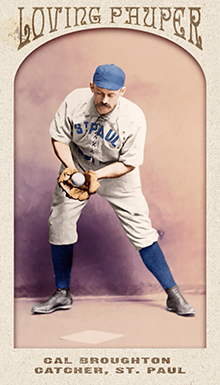
- Series: 1880s: Loving Paupers
- City: St. Paul
- Team: Apostles
- League: Western Association
Cecil Calvert Broughton (1860-1939) had a lifelong love of baseball. He began playing on the amateur diamonds around Evansville, WI and became one of his State’s first major-leaguers with the Cleveland Blues in 1883. After brief stints in the top-tier, Cal played with minor league and local clubs. At the end of his estimable life, having served as Evansville’s first police chief and civil servant, Broughton enjoyed listening to games on his radio as his life ebbed. Everywhere Cal played, news reports spoke of a beloved player, coach and man. Primarily a catcher, Broughton was known for his “head for the game” and his skill at managing pitchers. Brief stints with six teams from 1883-88 comprised his MLB tenure, while the bulk of his playing time was in the minors.
- A beloved local hero, Cal captured train robbers in a gunfight, and pinched the area’s first car thieves in 1913
- His salary as the first elected top cop: a sumptuous $35 a month
Auction History
Cartophilia
Old Judge Pose: 42-5
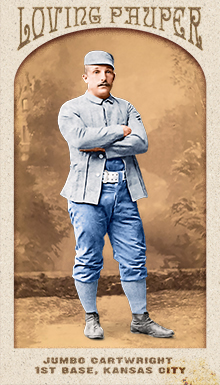
- Series: 1880s: Loving Paupers
- City: Kansas City
- Team: Blues (WA)
- League: Western Association
Edward Charles Cartwright (1859-1933) was built to anchor first base and, once he finally made it to the majors at age 30, he did just that; first for the Browns in 1890 and then for four straight seasons with the Washington Senators of the National League from '94-97. The stocky 5'10” 220 lb infielder hit well until his final season, better than he had in the minors. His rookie year saw him hit .300 while driving in 60 runs. After a three-year hiatus, he continued his excellent offense, highlighted by a .331 average in 1895. He carried his weight well, evidenced by the fact he still ranks 13th all-time among base stealers who played for D.C. teams. Jumbo began with Youngstown in 1883 and had one season -1886- with the Acid Iron Earths in Mobile for the Gulf League, one of the more intriguingly-named clubs in the universe of minor league baseball that had some doozies. He was with New Orleans in '87 then Kansas City and St. Joseph (another of those tantalizingly-dubbed clubs-the Clay Eaters) before heading north to Montreal in the International Association to begin the 1890 campaign prior to his call to St. Louis for his MLB debut. Despite hitting .300 in 75 games for the Browns, Ed was sent west where he played for San Francisco, Tacoma and Missoula before returning closer to home with Memphis for the '93 season. He was released by the Senators in mid-1897 and played a few more games with the Minneapolis Millers as his pro career came to an end.
- Jumbo had a game whose output at the plate justified his nickname. On September 23, 1890 he drove in seven runs in one inning, setting a mark that would stand for 109 years until another St. Louis warrior, Cardinal Fernando Tatís, hit two grand slams off the Dodgers' Chan Ho Park in the third inning on April 23, 1999
Auction History
Cartophilia
Old Judge Pose: 70-1

- Series: 1880s: Loving Paupers
- City: Chicago
- Team: White Stockings
- League: National League
- Hall: National Baseball Hall of Fame
John Gibson Clarkson (1861-1909) won 328 games, won the triple crown in 1889 and twice pitched more than 600 innings in a season. In 1885, John appeared in 70 games, threw 68 complete games, 623 innings, won 53, had an ERA of 1.85, a no-hitter, and won the pennant. Apparently having to hurl the sphere a mere fifty feet was a tonic to the arm. But unlike so many pitchers of his era, Clarkson didn’t flame out from such prodigious labor on the mound. From 1885-92 he AVERAGED 36 wins per season and would win 30+ an extraordinary six times. This great career began with the Worcester Ruby Legs in 1882, flowered with Cap Anson’s Sox in ‘84 and fully bloomed in Boston when John followed his ace catcher King Kelly to the Beaneaters in ‘88. League politics that culminated in the Players’ League revolt took a toll on Clarkson’s reputation and sundered his friendship with Kelly as the hurler remained loyal to the Nationals.
- Cleveland acquired John in 1892 allowing him to team with Cy Young. Chief Zimmer, who caught Young for a decade, proclaimed Clarkson the best he ever saw
- Elected to Hall of Fame: 1963
Auction History
Cartophilia
Old Judge Pose: 78-7

- Series: 1880s: Loving Paupers
- City: New York
- Team: Giants
- League: National League
Elmer Ellsworth Cleveland (1862-1913) was a third baseman and shortstop who was a good enough hitter to carve out a very respectable pro career, principally in the minors. He began with Johnstown of the Western Interstate League in 1883 and, as so many of his talent and age, got a chance at the “big leagues” the following season with the Cincinnati Outlaw Reds, the aptly-named club in the upstart Union Association. Elmer actually had a great season for Cincy playing against other mostly minor league talent. He hit .322 in 29 games. His limitations as a hitter caught up to him in his future appearances with major league teams. He next came up with the New York Giants in 1888, getting into nine games before being shipped to Pittsburgh's Alleghenys where he got into 30 games. His combined average tumbled to .235. Cleveland got one more shot, with the Columbus Solons of the American Association in 1891 where his miserable .171 average signaled the end of any dreams of big league glory. Nevertheless, he stayed in minor league baseball through his twenties, finally calling it quits after playing the 1892 season back in Johnstown with the Pirates, now in the Pennsylvania State League and finishing up the year with Danville in the same circuit. His opponents that year included the Wilkes-Barre Coal Barons, the Reading Actives and the Lebanon Pretzel Eaters.
- Cleveland must have cut an imposing figure in that era, standing 5'11” and tipping the scales at 190 lbs. However, the sturdy third baseman learned the unfortunate consequences of not hitting one's weight
Auction History
Cartophilia
Old Judge Pose: 80-2

- Series: 1880s: Loving Paupers
- City: New York
- Team: Giants
- League: National League
- Hall: National Baseball Hall of Fame
Roger Connor (1857-1931) was the home run king of the 19th century, clouting 138 in his 18-year career. His record stood for 23 years after his retirement, until Babe Ruth surpassed him in 1921. Connor anchored first-base for five teams, winning pennants twice with the Giants. His flair for the dramatic was never more evident than when he struck the first-ever major league grand slam with his team down by three with two outs in the ninth. Born in Connecticut, Roger played for local clubs until joining the Troy Trojans in 1880. That NY hamlet witnessed five future Hall of Famers on their squad with Connor playing alongside Dan Brouthers, Buck Ewing, Tim Keefe and Mickey Welch. After moving to the Gothams, the 6’3” Connor inspired owner Jim Mutrie to proclaim the team “my giants!” and a new identity was born.
- Much more than a slugger, Connor won the NL batting title in 1885 and consistently hit .300+ while exhibiting remarkable speed for a big man (still fifth all-time in triples)
- Connor lived to see Ruth claim his HR title. It was thought at the time, however, that Connor had hit 131 HRS and Ruth's record was celebrated at 132. Writing for SABR in 1975, John tattersall discovered that Connor had actually hit 138 HRs.
- Jay Jaffe's JAWS system ranks Connor as the 5th greatest 1st baseman of all-time, just behind Cap Anson and just ahead of Jeff Bagwell
- Beloved by fans and the baseball press, he had a particularly strong advocate for the Hall in fellow legend, umpire Bill Klem
- Elected to Hall of Fame: 1976
Auction History
Cartophilia
Old Judge Pose: 88-3
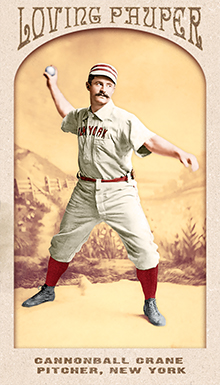
- Series: 1880s: Loving Paupers
- City: New York
- Team: Giants
- League: National League
Edward Nicholas Crane (1862-1896) began in major league ball with the notorious Boston Reds of the Union Association - a hard-drinking crew. It appears that big Ed avoided the bottle that would eventually kill him years later when he joined Al Spalding’s world exhibition tour. That he even made that trip was highly unlikely as Cannonball had labored in anonymity for years until the 1889 “World Series,” where Jim Mutrie played a hunch and decided his Giants could best the Bridegrooms with fastballs. Crane was tapped for five starts, won four and the Series. Cannonball could always throw hard and was famed for a 406’ long-toss, but such post-season heroics were virtually unheard of. The seeds of Ed’s doom had been planted on that tour however, nourished by the vices of Paris. All too soon he would spiral into alcoholism and an early death. While the coroner ruled Crane's death an accidental overdose, rumors persisted that he had taken his own life by drinking acid.
- Ed had one of the great seasons of any pitcher for the Toronto Maple Leafs in ‘87 with 33 wins and an eye-popping .428 BA (when walks counted as hits)
- Other firsts: 1st NY Giant to hurl no-hitter; 1st pitcher with four Ks in an inning
Auction History
Cartophilia
Old Judge Pose: 96-6

- Series: 1880s: Loving Paupers
- City: Philadelphia
- Team: Quakers
- League: National League
- Hall: National Baseball Hall of Fame
Edward James Delahanty (1867-1903) died in the icy waters of the Niagara River while still in his baseball prime. He was hitting .333 for the Senators that July of 1903, well below his days with the Phillies, but still a force to be reckoned with after a 16-year career in left field. Through the 1890s no hitter dominated as did Big Ed. With Sam Thompson and Billy Hamilton he formed an outfield-for-the-ages, each hitting .400+ in 1894. He struggled during his early years until, driven to excel, Ed transformed himself at the plate. Personal achievement had not brought a pennant, however, and Delahanty experienced the frustrations of the reserve system in his pursuit of the pay he felt was his due. As with so many players of that day, Ed turned to the bottle and was given to outbursts such as the one that got him ejected from the train the night he died. His tragic end came amid one of the great careers in baseball history.
- Only player to win batting titles in both AL & NL
- First to hit .400 three times
- Fifth all-time in career batting average (.346)
- 2nd player to hit 4 HRs in a game
- Elected to Hall of Fame: 1945
Auction History
Cartophilia
Old Judge Pose: 123-3
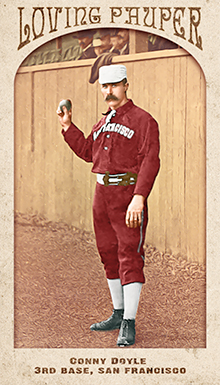
- Series: 1880s: Loving Paupers
- City: San Francisco
- Team: Haverlys
- League: California League
Cornelius J. Doyle (1862-1931) was an Irish immigrant who played outfield for two seasons in the major leagues. He was with the early forerunner to today’s Phillies, the Quakers, in 1883. He had one more attempt at staying at the top of his profession with the Pittsburgh Alleghenys of the American Association in 1884. The AA lasted for a decade following its founding in ‘82. The Alleghenys would eventually morph into today’s Pirates. Conny’s tenure was brief and his stints with both clubs equally so. He saw action in 16 games for the Quakers and 15 for Pittsburgh. He sported an anemic .221 average in his rookie campaign, but finished with a flourish as he hit .293 with the Alleghenys.
Doyle had begun at the pinnacle of baseball, the National League, in ‘83 as a twenty-one year old. His poor batting sent him down to the Northwestern League’s Quincy (IL) Quincys in 1884 where his fine .304 average earned him the next shot with Pittsburgh later that year. He led the Quincys with four home runs playing aside ten other future major leaguers, including Ice Box Chamberlain and Kid Baldwin. Doyle knocked around the minors for the next decade, playing regularly for the likes of the Lynn (MA) Shoemakers, Atlanta Atlantans, Peoria Canaries and the New Haven Nutmegs. In 1889 Conny was captured by photographers in his San Francisco Haverlys uniform during a brief west coast assignment. He closed his pro career with two widely-dispersed teams in 1893: the Dover club of the New England League and the New Orleans Pelicans of the Southern Association. This young immigrant found baseball an ideal vehicle to tour his adopted land.
- At age 31 Doyle was far from the grizzled veteran of the Pelican squad. Dick Phelan was 38 and two other teammates were senior to Conny
- One of those teammates was Kid Baldwin, indicating the twists and turns of pro ball in the 19th century. The Kid and Conny were rookies in Illinois and followed very different routes in their respective careers, but both found themselves closing out their baseball lives with the same New Orleans franchise in 1893
Auction History
Cartophilia
Old Judge Pose: 133-1

- Series: 1880s: Loving Paupers
- City: New York
- Team: Giants
- League: National League
- Hall: National Baseball Hall of Fame
William Ewing (1859-1906) was the premier catcher of the 19th century, honored for decades after his early death as even, perhaps, the greatest player of all time. A scourge at bat, Buck hit over .300 ten times. He played behind the plate with courage and style, crouching close to the hitter so as to shave precious seconds off his inerrant throws. Ewing had debuted with the remarkable Troy Trojans in 1880 and joined four future Hall-of-Famers in moving to NYC in ‘83. The sturdy catcher may have been the primary inspiration for Jim Mutrie’s “my Giants!” exclamation that led to the new identity of the Gothams. An arm injury on a raw spring day curtailed his tenure behind the plate from 1891 on. Such a magnetic figure couldn’t escape the turmoil of the Players’ League controversies and Ewing was sometimes pilloried for lax effort. Despite such caviling, Ewing left as indelible a mark on the game’s first century as anyone. Upon his induction to Cooperstown (among the first six of the “pre-modern” era), he was hailed by Connie Mack as the greatest catcher he had seen and he had seen most.
- “Buck” was a derivative of “Buckingham,” bestowed on the budding star by an admiring scribe who wanted to add gravitas to the youngster’s reputation
- Played all nine positions and managed 3 different teams over 7 seasons
- Was the first catcher elected to the Hall of Fame; and the second 19th century player elected (after Cap Anson)
- Elected to Hall of Fame: 1939
Auction History
Cartophilia
Old Judge Pose: 149-5
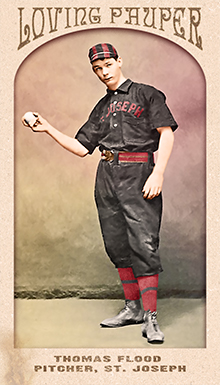
- Series: 1880s: Loving Paupers
- City: St. Joseph
- Team: Clay Eaters
- League: Western Association
Thomas J. Flood (1867-?) never made it to the major leagues, but his Old Judge card series in 1889 placed this young Missouri ballplayer among an elite of his day. He was captured by the photographer in his St. Joseph Clay Eaters uniform cutting a dashing figure as a right-handed pitcher. Indeed, The Sporting News noted that Thomas had been the Houston Babies’ star hurler the prior year, going 11-15 for a struggling franchise. He was again the stalwart of that team in ‘88 when he compiled a miserable record of 2-10, but started the majority of games, completing the entire dozen. Only one of that squad’s pitchers ever had big league experience. That was veteran Doc Landis who was in the final year of his career that had begun with American Association teams in 1882. The Texas Southern League in those days consisted of a mere six clubs, including the San Antonio Missionaries and Dallas Hams. Flood had started out with amateur outfits in his native St. Louis, such as the Prickly Ash and Grand Avenue clubs. The Sporting News mentioned his first professional job was with Springfield, MO in 1887 where he was said to have won every start for the Indians of the Southwestern League. Unfortunately, Flood’s auspicious beginning ended abruptly with the demise of the Springfield franchise. He was picked up by Ft. Smith to finish the season. With the Clay Eaters, Thomas found himself among a staff with better talent. Five of his fellow pitchers would see big league service. He went 9-16 in ‘89, the third-best record on the team.
- Despite missing out on MLB glory, Flood was celebrated by The Sporting News as “the finest pitcher in the Southwestern League.” Not a bad clipping to show the family
Auction History
Cartophilia
Old Judge Pose: 164-4
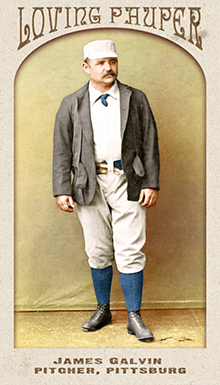
- Series: 1880s: Loving Paupers
- City: Pittsburgh
- Team: Alleghenys
- League: National League
- Hall: National Baseball Hall of Fame
James Francis Galvin (1856-1902) sported some colorful nicknames: Pud, Gentle Jeems and The Little Steam Engine, indicative of his renown. Pud was baseball’s first 300-game winner. He pitched for six teams over 15 years, and remains the only player to win 20+ games in ten seasons and not win a pennant. Only Cy Young pitched more innings or hurled more complete games, a testimony to the extraordinary demands placed on starters in the 19th century. Perhaps no pitcher of any era accomplished so much by overcoming a distinct physical limitation. In Galvin’s case, it was his small hands which left him unable to completely grip a baseball. He couldn’t throw the curve so he adapted, becoming an expert in “drops, straight balls and the different artifices known to pitchers to deceive the batter” as he told a friend. As his steam engine nickname suggests, Pud just rolled right at the hitter with power and durability yet with amazing finesse, especially in holding runners on base. Buck Ewing was a great admirer and said he wouldn’t have had anyone attempting steals with Galvin on the mound.
- Galvin threw no-hitters in 1880 and ‘84
- Began and ended his long career in St Louis with the NA’s Brown Stockings and NL’s Browns
- Elected to Hall of Fame: 1965
Auction History
Cartophilia
Old Judge Pose: 177-2

- Series: 1880s: Loving Paupers
- City: Chicago
- Team: White Stockings
- League: National League
Emil Geiss (1865-1911) emigrated from his birthplace, Villmar Germany, to Chicago. The youngster began his experience in professional baseball out in Colorado with the Pueblo Pastimes of the CO State League in 1885. The scanty records for minor league play in those days record Emil started two games, finished them both and went 1-1. There is no data for Geiss’ activities the following year, but one might suppose he did something somewhere to impress the Chicago White Stockings as the National League power thought fit to sign Emil for the ‘87 season. Whatever Cap Anson’s hopes were, they died aborning as Geiss languished with the team. He got shelled in his one start (11 runs, eight earned) and not only left the major leagues, he left his adopted land. Geiss signed the following two seasons with London Ontario Canada’s Tecumsehs of the International Association and stayed for the 1889 campaign when the Tecumsehs joined the International League. In those two years Geiss was 21-21 . But for his sole outing in Chicago, he would have completed his pro tenure with a symmetrical record of 22-22.
- There is no doubt Emil belonged in the pitcher’s box as his hitting gave no indication he could perform anywhere else. He never cracked the .200 mark and was one for 12 with the White Stockings. His three errors in his brief time in the majors suggest it wasn’t just his bat that would be a detriment to longevity at that level
- The reason Geiss had twelve at bats in Chicago is that Anson put him at first base and second base in two other appearances
- Emil’s older brother Bill also saw major league duty, playing two seasons. He debuted with Baltimore in the American Association in 1882 and then joined the Detroit Wolverines of the NL in ‘84
Auction History
Cartophilia
Old Judge Pose: 182-2
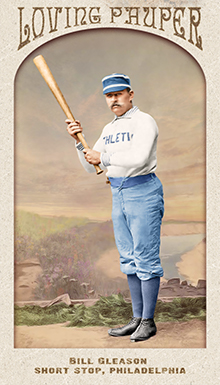
- Series: 1880s: Loving Paupers
- City: Philadelphia
- Team: Athletics (AA)
- League: American Association
William G. Gleason (1858-1932) was an American Association shortstop for three teams from 1882-89. During those eight seasons Gleason hit .267. He debuted with his hometown St. Louis Brown Stockings and participated in their three pennants in '85, '86 and '87. He was an everyday player and increased the number of games played every year with the club, culminating in '87 when he appeared in 135 games with a fine .288 average. St. Louis management must have anticipated a decline was in store. He was traded to Philadelphia's Athletics in '88, where his hitting fell off to .224. Philly dealt him to the Louisville Colonels for his final campaign. Gleason saw action in only 16 games in 1889. He stayed in pro ball for two more minor league seasons with Washington of the Atlantic Association in 1890 and finished up with the Rockford Hustlers of the Illinois-Iowa League the following year where he recorded by far the highest average on a squad that included eight other past or future big leaguers.
- In a storied and rowdy “championship” contest following the 1885 season, Gleason's Browns vied with the formidable White Stockings. Bill was at the center of the storm as his throw to first was ruled late, infuriating the home folks and precipitating a long row in which Cap Anson refused to allow the Chicago umpire to be replaced. Comiskey called his team off the field which led to a forfeit of the first game. The “Series” ended in a tie.
Auction History
Cartophilia
Old Judge Pose: 193-2
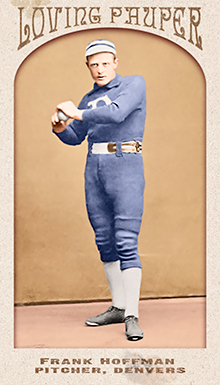
- Series: 1880s: Loving Paupers
- City: Denver
- Team: Grizzlies
- League: Western Association
Frank J. Hoffman began in professional baseball with the New Orleans Pelicans in 1887. Frank appeared in two games, is shown as having been age 25 at the time, and was the pitcher of record for both starts. He surrendered seven runs, none of them earned, and was 1 for 9 at the plate. He saw a bit more action the next year with the San Antonio Missionaries of the Texas-Southern League. He started eight games and was spectacular, going 7-1 with a .91 ERA. This was an abbreviated turn with the Missionaries. Although unrecorded by Baseball Reference, the Goodwin editors state that the San Antonio squad had begun the ‘88 season as the Austin Senators. The previous franchise in the Alamo city had gone out of business. On July 4 the Senators came to town, but they didn’t do any better drawing customers. After only the eight games, Hoffman was sold to the American Association’s Kansas City Cowboys. This opportunity provided Frank his sole chance to pitch in the big leagues. He couldn’t match his performance down south, going 3-9 with a still-respectable 2.77 ERA. He was released for the 1889 season and played for the Denver Grizzlies, where he was captured on camera by an Old Judge photographer for five known poses before returning to Texas with the Houston Mudcats for the 1890 campaign. He had a good enough ERA at 2.30, but lost 12 of his 17 decisions. His final known year in pro ball came in 1892 with the San Francisco Metropolitans of the California League. Team data show an eye-popping 39-37 record with an ERA of 1.72. It appears that Frank may have adopted San Francisco as his permanent home, having died there in 1916, 24 years after leaving baseball.
- Despite Hoffman's obscurity, he enjoyed one of baseball's most celebratory but confounding nicknames: The Texas Wonder. Because Frank was most likely born in Mississippi, one might surmise he earned the sobriquet during his 1888 career year with the San Antonio Missionaries, when he went 7-1 with a .91 ERA
Auction History
Cartophilia
Old Judge Pose: 228-1

- Series: 1880s: Loving Paupers
- City: Cleveland
- Team: Blues (AA)
- League: American Association
Mortimer Edward Hogan (1862-1923) broke into pro ball in 1883 with the Peoria Reds. The young outfielder got the first of two shots at the big time the following season with the Milwaukee Brewers of the soon-to-be-defunct Union Association. Even had the league survived that turbulent year, it is virtually certain that Hogan's .081 batting average would have doomed him to return to the minors. He spent most of '84 with the Milwaukee Northwestern League club after the UA went belly up. Hogan at least hit his weight here, bumping his average up to .217. The light-hitting Hogan remained in the minors, bouncing from the Southern League to the Western League and to Elmira of the New York State League before returning south to two Georgia squads for most of the '86 season. He moved back to the WL's Leavenworth Soldiers to finish the campaign before getting another opportunity in the majors with the American Association's New York Metropolitans where his .200 average might have been overlooked as the team struggled to a 45-88 record and a dismal seventh place finish. Well, apparently Mort's weak hitting wasn't ignored as the woeful Mets shipped him to Nashville to finish out the '87 season. But all was not dark for Hogan as he was given one last chance at big league glory with the 1888 Cleveland Blues of the AA, where he managed a .227 average. The Cleveland management, having witnessed the futility of Hogan and the Mets the prior year, still held out hope, signaling the eternal optimism that defines America's pastime.
- Perhaps Mortimer had the last laugh as the Blues managed a sixth place finish in '88, an improvement that launched Hogan into retirement at the age of 26
Auction History
Cartophilia
Old Judge Pose: 229-5

- Series: 1880s: Loving Paupers
- City: Chicago
- Team: Maroons
- League: Western Association
Frederick W. Lange began his pro ball career as a teenager (how young is in dispute). He was from the San Francisco Bay Area and played in 1886 for the Greenhood and Morans team of oakland, a charter member of the California State League. The owners were haberdashers in Oakland who sponsored the club for three years. In 1887 the team floundered in last place despite having a lot of talent. The loss of star pitcher George Van Haltren, who went east to begin a long major league career, was a big blow. Fred Lange was a pal of Van Haltren’s and followed him to NY.
There is a fair degree of uncertainty and confusion surrounding Lange’s career, some of which appears to have been instigated by Lange himself. He had changed his surname to "Dolan" to sign with the G & Ms in Oakland so his parents wouldn’t know of his unworthy occupational choice. (Anyone familiar with the American Association’s reputation as the “beer and whiskey league” can sympathize with Fred’s folks as the 1880s were an era of free-wheeling debauchery in big time baseball.) But there is a reference by authors Dick Dobbins and Jon Twichell in their book Nuggets on the Diamond:Professional Baseball in the Bay Area from the Gold Rush to the Present, published in 1994, to the effect that Fred Lange was also “Willard Brown,” who went on to play for the NY Giants after leaving Oakland in 1886. Catcher William "California" Brown did play for the Giants from 1887-1889 and, perhaps not coincidentally, had played for Greenhood and Morans as well. Adding to the confusion, the editors of The Photographic Baseball Cards of Goodwin & Co mistakenly list William Brown as "Willard" in that seminal encyclopedia on the Old Judge universe. One possible theory to the confusion, however unlikely, is still intriguing: In moving East to pursue his big league dreams, might Fred Lange have adopted the name "Willard Brown" as a sort of hopeful and opportunistic nominal doppelganger to William Brown?
The truth is, most likely, that the mystery and confusion around Fred Lange's name and identity is the result of a more modern human error and that there is no mystery at all. Fred Lange & William Brown are clearly different people, perhaps even friends, who look nothing alike and appear together in a Greenhood & Morans team photo from 1886, thereby dispelling the notion that Brown was Lange's alter ego. Furthermore, there is no record of a "Willard Brown" playing professional baseball in the 19th century and the Old Judge folks were unconfused on the players' identities, with each player getting five unique poses in the series with no misspellings, overlay or confusion between them. Given that Van Haltren knew both Lange and Brown and that Van Haltren and Brown had quickly established themselves as bone fide big leaguers, it seems unlikely that Lange would attempt to perpetrate such a thinly veiled con while striving to join his friends on the big stage.
- Further adding to the confusion around Lange's name, the New York Metropolitan Museum of Art mistakenly lists Lange as "Lance" for the two Old Judge cards of Lange that reside in the museum's collection.
- Lange later authored an influential tome of his own: History of Baseball in California and Pacific Coast Leagues (1847-1938)
Auction History
Cartophilia
Old Judge Pose: 272-4

- Series: 1880s: Loving Paupers
- City: St. Paul
- Team: Apostles
- League: Western Association
Willard Eben Mains (1868-1923) had only a few brief appearances in the majors as a pitcher. He was 1-1 with the Chicago White Stockings of the National League in 1888 after starting in pro ball with Portland of the New England League the previous season. He returned to the minors in the Western Association and would go on to a successful career in the lower echelons, winning 318 while losing 179. In 1891 Grasshopper got a little longer opportunity with the American Association's Cincinnati Kelly's Killers and Milwaukee Brewers where he went 12-14. It would be another five years before his last shot in the big time, with Boston's Beaneaters in '96, where he was 3-2.
Mains, also known as Willie, was a product of one of the oldest families in his native Maine. He came out of Windham and would make a name for himself manufacturing bats. He had at least three factories in Sandy Creek, Harrison and Fryeburg, but marketed his product nationally. A Mains Dolley 31” bat circa 1890s recently sold for $400.
- Over his entire 20-year career in professional baseball, Mains played for 17 teams. He stayed in upstate New York for his final decade, closing out his tenure with the Binghamton Bingoes in 1906 after two lengthy tours with the Rome Romans and Syracuse Stars
- Willard inspired his son Jim to pursue careers in both baseball and bats. James R. Mains played first for Harvard in 1942 and got one appearance in the majors, with the Athletics, in August '43 where he lost his only start. Jim established his bat-making operation in Bridgton, Maine
- Perhaps it was his pedigree as a scion of the Down Easters that prompted the Old Judge photographer to record Grasshopper's surname as "Maines" on his St. Paul Apostles card series
Auction History
Cartophilia
Old Judge Pose: 290-2
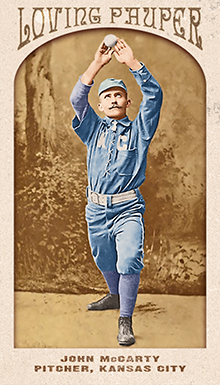
- Series: 1880s: Loving Paupers
- City: Kansas City
- Team: Blues (WA)
- League: Western Association
John A. McCarty (1867-1942) pitched in professional baseball for five years with one season in the majors. McCarty began at age 20 with the Emporia Reds of the Western League, starting eight games (tied for the most on the team that brief stint) and losing six despite a team-leading 2.92 ERA. He moved to the WL’s Kansas City Cowboys later in the year and went 3-2 on a large roster led by Kid Nichols who starred in his first professional season with an 18-12 record. The following year KC joined the Western Association as the Blues. They clearly liked what they had seen in ‘87 and retained McCarty for the ‘88 campaign. The young hurler rewarded the franchise with an excellent year, winning 21 games against 11 losses with a 2.42 ERA. Despite the 21 wins, Kid Nichols outshone McCarty again, winning 16 of his 18 games pitched with a remarkable 1.14 ERA. True to its decade, with leagues evolving and franchises morphing, 1889 found McCarty with a major league team without changing his address. He now pitched for the Kansas City Cowboys of the American Association. Unfortunately for John and his team, genuine big league competition exposed good minor league players. Nichols was in Omaha pitching to a 39-8 record, the Cowboys sank to seventh in the league and McCarty saw limited duty in just 15 games, winning eight and losing six with a 3.91 ERA in his lone major league campaign. He was demoted to the WA’s St. Joseph Clay Eaters for the remainder of ‘89 where he did start 15 games, but won only five. He had one more try with the Detroit Wolverines in their International Association incarnation in 1890, achieving a 9-9 record in a truncated season.
- BaseballReference.com records McCarty was on the roster for the 1891 KC Blues of the WA, but he appeared in only one game, giving up twelve hits and eight runs (two earned) in six innings and earning a no decision
Auction History
Cartophilia
Old Judge Pose: 302-3

- Series: 1880s: Loving Paupers
- City: Pittsburgh
- Team: Alleghenys
- League: National League
Alexander J. McKinnon (1856-1887) was a remarkably talented player who was cut down in his prime by a scourge of the 19th century, typhoid fever. The tragedy was even more poignant inasmuch as McKinnon had endured numerous illnesses in his youth that had prevented him from really beginning what was on its way to a very fine career. As if sickness wasn't enough of a hardship for young Alex, he was also hindered in the beginning of his pro tenure by league politics and evolving contractual arrangements. He had begun playing for the Syracuse Stars in 1877, staying in NY with Albany/Rochester for the '79 season before heading west to the San Francisco Athletics of the California League in 1880. This move was precipitated by a squabble that involved William Hulbert of the new National League. Alex was assigned to the Troy Trojans for the 1879 season, but wanted to play for Rochester of the International League. Despite some back-room dealings that should have cleared up the controversy, Hulbert expelled McKinnon. A combination of illness that plagued him lifelong and this contract dispute seems to have led him to make the move west and then drop out of baseball altogether for a few years. Clearly McKinnon's talent was recognized and Hulbert relented, allowing Alex to be signed for the '83 season by the Philadelphia Quakers - but the young man was too sick to play. Finally, in 1884, the New York Gothams (not yet the Giants) signed Alex and he began a belated major league tenure that showed tremendous promise. Indeed, in the four short years he played for three NL teams - NY, St. Louis and Pittsburgh - Alex steadily improved his batting average. He hit .272 for the Gothams, jumped to .294 and .301 with the Maroons and was hitting a stunning .365 in 1887 when he was stricken with an ailment he couldn't lick, typhoid. After his mid-season death, the Alleghenys honored Alex by donning black crepe for the duration of that campaign.
- McKinnon was not just a good and ever-improving batter, he became a star in the field. He led the NL in fielding percentage in 1885 with a .978 record. This was all the more striking given his difficulty at first base for the Gothams the prior year when he made 53 errors. Clearly this star-in-training was a quick study
Auction History
Cartophilia
Old Judge Pose: 315-1

- Series: 1880s: Loving Paupers
- City: Milwaukee
- Team: Creams
- League: Western Association
George William McVey (1865-1896) had a much-traveled professional career in baseball, almost all of it in the minors. He played for 20 different franchises beginning in 1884 with the Chillicothe Logans of the Ohio State League and ending with the Quincy Browns of the Western Association in 1895. Along the way he made stops in the Southern League/Association, Tri-State, Texas-Southern, Central Interstate, Pacific Northwest/Interstate and Ohio-Michigan Leagues. George’s sole chance to see action in the major leagues came with the Brooklyn Grays of the American Association in 1885. He played catcher and first base for Brooklyn, but only got into six games where his .143 average led to his return to the minors. That same season saw “Big George” back in Atlanta where he caught the attention of The Sporting News who reported on September 23 that he had “made quite a reputation as a catcher and outfielder in the Southern League.” The sturdy McVey stood 6’1” and, by the end of his career, was known for his size as noted in another Sporting News item from August, 1895: “Big George McVey is playing a good game at first . . . and is hitting at a four hundred gait.” Tragically, this would be his last and best ball. He was reported in April ‘96 to be suffering bowel troubles. He died the following month in Quincy, Illinois.
- A clue to McVey’s peripatetic sojourn in baseball comes from a report in the Milwaukee Sentinel on May 9, 1889 where it was stated that George and Creams teammate Billy Klusman “were released for getting on a spree in St. Joseph.” If this was indicative of a dissolute lifestyle, McVey would hardly be the first of his era’s players to succumb to the temptations and deprivations of the times that shortened far too many careers
Auction History
Cartophilia
Old Judge Pose: 321-3

- Series: 1880s: Loving Paupers
- City: Milwaukee
- Team: Creams
- League: Western Association
Lynn Mills (1862-1937) was a native of Whitewater, WI. He moved to nearby Milwaukee to begin his professional baseball career with the Brewers in 1886. The team was also known as the Cream Citys or Creams after the distinctive local bricks made from a light-colored clay. We lack data on Mills' rookie season, but his performance in '87 was very positive. He batted .290, splitting time as a reserve at short and third. In 1888 the club transitioned from the Northwestern League to the Western Association and Lynn stayed with them through the '89 campaign. He got more playing time, but his average subsided a bit to .260 in '88 and .266 in '89. The following year Mills moved way out west to play for Spokane in the Pacific Northwest League where he had his most prolific year in all offensive categories. He hit .284 and had 103 base hits including 14 doubles as the regular catcher, a position he had played in Milwaukee. Sketchy minor league records indicate Mills returned to the midwest for the 1891 season with the Terre Haute Hottentots of the Northwestern League, but individual stats aren't available. Baseball Reference even shows him returning to Spokane, this time with the Indians of the Pacific National League in 1903, where the then 41-year-old is on the roster but with no record of positions played or batting statistics. It seems unlikely that Mills would have remained out of pro ball for a decade after showing good promise at the plate, especially for a catcher. It also seems unlikely that a youngster of his talent would have had no professional experience prior to age 24, when he is first shown to be with the Cream Citys. Sadly, extant minor league statistics leave too many gaps in our knowledge of the real contributions of stalwarts such as Lynn Mills.
- The Goodwin editors assert that Mills struggled with his defense in Milwaukee to the extent that, for the 1889 season, he ranked next-to-last in the Northwestern League in defense among catchers. Nevertheless, his ability to hit consistently would have assured him a job behind the plate for many teams in an era that devoured receivers who braved the job with little protective equipment
- Mills enjoys six known poses in the Old Judge canon
Auction History
Cartophilia
Old Judge Pose: 326-1

- Series: 1880s: Loving Paupers
- City: St. Paul
- Team: Apostles
- League: Western Association
John Thomas Pickett (1866-1922) was a utility infielder/outfielder who earned three brief chances in the major leagues. First, after tearing up the Western Association for St. Paul in 1888-89, John was given a try by the American Association’s Kansas City Cowboys late in the ‘89 season. He got to play quite a bit for a late-comer that year, getting into 53 games at three positions. He managed only a .224 average. Fortunately for Pickett, 1890 was a volatile year in the majors as the Players’ League siphoned off as much talent as they could lure to their rogue enterprise and John got a chance with the Philadelphia Athletics where he did much better, hitting .280 in 100 games. The diluted talent allowed many of the Players’ players to excel that single year of the league’s existence, similar to what had happened in 1884 as the Union Association played spoiler to baseball’s establishment. Two years later Pickett got his last chance in the big leagues with the cellar-dwelling Orioles. Tommy Lasorda has famously postulated that the best teams lose a third of their games and the worst win a third of theirs. Baltimore defied Tommy’s sage observation by winning 19 and losing 54 en route to a last place finish in the AA in ‘92. He hit .213 for the struggling Birds - totally unlike his usual solid hitting in the minors. John had begun in pro ball with Stillwater of the Northwestern League in 1884 and played later for Milwaukee and Minneapolis in the same circuit. He was still hitting near .300 in his final Western Association appearances with Kansas City and Minneapolis in 1897 as he wrapped up his time in the minors.
- One sweet note that Pickett could take with him was that when the Orioles let him go, he was replaced at second base by a young firebrand named John McGraw
Auction History
Cartophilia
Old Judge Pose: 369-2
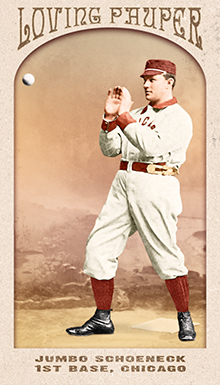
- Series: 1880s: Loving Paupers
- City: Chicago
- Team: Maroons
- League: Western Association
Lewis N. Schoeneck (1862-1930) came by his nickname honestly, standing 6'2” and 223 lbs, a true Gargantua in his day. Despite his size and presumed strength, Schoeneck proved better suited to the minors than the big leagues. His decade in pro ball was mostly in those smaller circuits and, apart from his season with the Union Association in which he played for two clubs and saw pitching a decided cut below true major league caliber, his batting average was consistently much higher in the minors. This is, of course, not unique by any means and the big first baseman was able to perform very well for most of the franchises he played for. Thanks to the renegade UA that siphoned off a lot of upper-tier minor league talent to make its attack on National League dominance in 1884, many of its players enjoyed one sunny season hitting well above their pay grade. Jumbo, for example, was in the top ten in the league in many offensive categories, including BA, OBP and Slugging Percentage. Since his only other major league time came four years later with the Indianapolis Hoosiers of the NL, his summer of love with the Pittsburgh Stogies and Baltimore Monumentals (never mentioned in connection with baseball greatness) enabled Schoeneck to “retire” with a career major league batting average of .283. Not a bad accomplishment to tell the grandkids.
- During his first of two seasons with the Hoosiers in 1888, Jumbo was summoned to relieve in two games. He hurled 4.1 innings, surrendering five hits and four runs without a decision. All of the runs were unearned giving him a phenomenal career ERA
- Neither of Jumbo's UA clubs performed too badly, but all of the league's other teams were crushed by the St. Louis Maroons who made mincemeat of the competition. The lop-sidedness of the runaway Maroon steamroller played a large part in demoralizing the fans and leading to the league's demise after that storied '84 campaign. St. Louis was a big winner in another, more important way. Their achievement led to the franchise graduating to the NL in 1885 where they became cellar-dwellers
Auction History
Cartophilia
Old Judge Pose: 404-4

- Series: 1880s: Loving Paupers
- City: Minneapolis
- Team: Millers
- League: Western Association
John Shaw made his mark in 19th century baseball via his six-photo spread in the Old Judge catalog when he was pictured in his Minneapolis Millers uniform in 1887/88. John had been the regular shortstop for the Millers in ‘87, but as the next campaign began he was shuttled down to New Orleans in what was described by The Sporting News as a cost-saving move by Minneapolis management. Shaw was said to be “a rattling good hitter and a fine base runner.” Yet, the News speculated he was let go because he was a “high priced man whom the club did not want.” The team had signed future major leaguer Joe Walsh to play short and Shaw was expendable. John had begun in 1884 with the Boston Reserves of the Massachusetts State Association and knocked around New England with Portland, Brockton, Newburyport and back to Boston’s Blues in 1886. Shaw’s move to the Twin Cities allowed him to post his career year in ‘87. He hit .292, playing every day at shortstop. The forced move south didn’t sit well with poor Shaw. He joined the Pelicans for the 1888 season and found himself mired in a slump that left him with a pitiful .143 average in a mere four games. The spotty minor league data of the era show only that Shaw finished the ‘88 season with Easton of the Central League with no stats available.
- The Sporting News coverage of Shaw’s move to the Crescent City gives a glimpse into the day-to-day updates available for fans of the era. The reporter noted that “Advance money and a ticket was sent Shaw this morning and he will come south at once.”
- One is left to surmise that John had to pay his own way to Pennsylvania for the ignominious conclusion to his tenure in pro ball
Auction History
Cartophilia
Old Judge Pose: 414-1
























